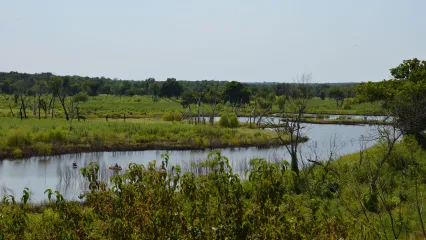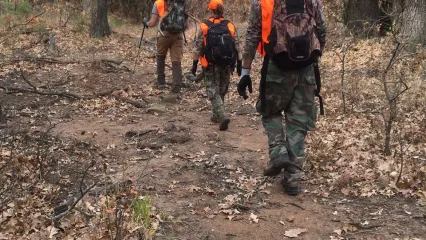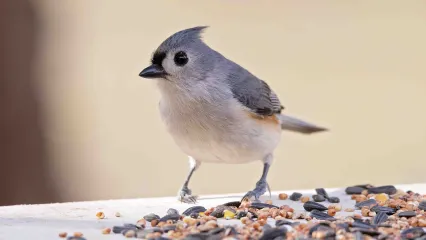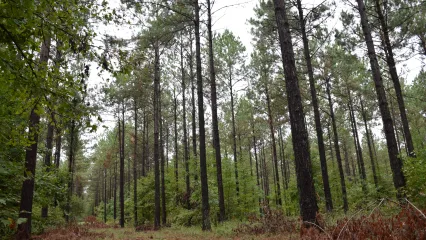
Contacts
Area Details
Keystone WMA covers 22,393 acres of Creek, Osage, and Pawnee Counties in north-central Oklahoma. Located near the towns of Cleveland, Mannford, and Oilton, Keystone WMA is comprised of the Arkansas and Cimarron rivers and adjacent flood plains and bottomlands.
The Arkansas and Cimarron Rivers are wide shallow major drainages in the state and with their sandbars, they comprise about 20% of the WMA acreage. Adjacent to the rivers are forests dominated by willow and cottonwood. As the elevation rises from the rivers, the WMA transitions to a mixture of bottomland hardwood trees, cropland fields, old fallow farm fields, and smaller areas of upland habitat. There are numerous sloughs, natural and man-made wetlands, and mudflats where the rivers deposit silt into the lake. Much of the water on the WMA is too shallow for boat traffic unless the lake elevation is high.
Keystone WMA – Arkansas River Unit
Along the Arkansas River and its tributaries between the towns of Cleveland and Blackburn, there are numerous access points, many of which can be accessed off State Hwy 64.
Keystone WMA – Cimarron River Unit
Along the Cimarron River and tributaries between State Hwy 48 and State Hwy 99, along Hwy State 51, west of Mannford.
- Waterfowl: Ducks are usually present in fair numbers. Resident geese are present in fair numbers.
- Deer: White-tailed deer are present in good numbers but are highly sought after.
- Rabbit: Cottontails are present and fair populations can be found at scattered locations in the upland habitats.
- Dove: Doves are usually present in fair numbers around manipulated fields.
- Quail: Bobwhites are present in low numbers at scattered locations in the upland habitats.
- Squirrel: Both gray and fox squirrels are present in good numbers.
- Turkey: Rio Grande wild turkeys are present at a very low density.
- Furbearers: Coyote, bobcat, raccoon, and beaver are available.
- Bald Eagle: Eagles are a fairly common sight along the rivers from November-March.
- Wading Birds: Present in moderate numbers throughout the year with several Great Blue Heron rookeries around the lake.
- Shorebirds: Present in high numbers in the lake summer and early spring during flood/drawdown operations at Cottonwood Creek WDU.
- Pelicans: Present year-round below the dam but can be found in high numbers around the lake from late summer through early spring.
Management efforts focus on producing native wildlife foods. Prescribed burns are conducted when conditions permit. Supplemental forage is provided through the management of farming leases and food plot plantings. Wetland development units are managed to provide additional waterfowl habitat and hunting opportunities.
Any location within 150 feet of a public-use road is available for primitive camping on the WMA. Campgrounds with electrical hookups can be found on Keystone Lake at Keystone State Park (918) 295-3310, or at Corps of Engineers managed parks (918) 865-2621.
Abundant fishing opportunities exist on Keystone Lake, the rivers, and their tributaries. Blue catfish, channel catfish, sand bass, and crappie are the species most sought after by WMA anglers. There are fair to good fishing opportunities for largemouth bass, flathead catfish, and striped bass on the main body of the lake.
That portion of the Arkansas Arm of the Keystone WMA that was previously the Waterfowl Refuge is open to restricted hunting. Lands in Osage County and the Arkansas River are restricted to archery and shotgun with pellets only. Lands in Pawnee County are restricted to archery only. The western boundary of these restricted hunting areas is a northern extension of Swan Drive in the city of Cleveland; the southern boundary is the old railroad trestle.
All shotgun hunting is restricted to federally approved nontoxic shot on the Boston Pool, Buckeye Creek and Cottonwood Creek WDU portions.
Same As Statewide Seasons
Seasons w/ Special Restrictions
- Deer Gun
Open during the first nine days only and Cottonwood Creek Wetland Development Unit lands are closed.
- Holiday Antlerless Deer Gun
Same as statewide seasons except Cottonwood Creek Wetland Development Unit lands are closed.
- Crow, Quail, Woodcock, Snipe, Rabbit, Squirrel, Predator/Furbearer Calling, Pursuit with Hounds for Furbearers
Closed during the first nine days of deer gun season.
- Turkey Fall Gun
Tom only, shotgun only.
- Duck, Merganser and Coot
Hunting hours for waterfowl close at 1 p.m. daily on the WDU portions.
- Trapping
Open to water sets, live box traps and enclosed trigger traps only.
- Turkey Spring, Youth Turkey Spring
One-tom limit; seasons combined, area combined.
Hunter and angler camping is allowed within 50 yards of open roads.
GreenCountryOK
1-800-922-2118
Oklahoma Tourism and Recreation Department
Post Office Box 52002
Oklahoma City, OK 73152-2002
(800) 652-6552 or (405) 521-2409
www.travelok.com
Sand Springs Chamber of Commerce
918-245-3221
www.sandspringschamber.com
Tulsa Convention and Visitors Bureau
Williams Center Tower II
Two West Second Street, Tulsa OK 74103
918-585-1201
1-800-558-3311
www.visittulsa.com
Q: Do I need a special permit to hunt on Keystone WMA?
A: No, all you need to possess in order to hunt on Keystone WMA is a valid hunting license and the proper unfilled tags if required (unless otherwise exempt).
Q: Can I hog hunt at Keystone WMA?
A: Yes, hogs may be taken on Keystone WMA during any established hunting season with methods authorized by the Department for that hunting season, except that during any open deer and/ or turkey season, only appropriate methods, hunting hours and legal equipment for that deer and/or turkey season are authorized for taking or pursuing feral hogs. No feral hogs may be removed alive from a WMA.
Pursuit of hogs with hounds is prohibited during the deer and turkey seasons on department managed lands. Pursuit of hogs at night is prohibited from Oct. 1 - Jan. 15 and during any spring turkey season. Pursuit of hogs at night during any other time of the year has the following restrictions: Use of a firearm is prohibited. In addition, persons pursuing hogs must comply with all other WMA regulations.
Resident & Nonresident License Requirements: All persons pursuing hogs must possess a hunting license, unless otherwise exempt. In addition, persons pursuing hogs on WMAs open during youth deer gun, bear muzzleloader (in open counties), deer muzzleloader, deer gun, Holiday Antlerless Deer Gun (in open zones), elk gun (in open counties) and antelope gun (in open areas) seasons with a shotgun and rifled slug, or any rifle or handgun larger than .22 caliber rimfire, must possess either a filled or unfilled license appropriate for the current season, unless otherwise exempt.
Q: Can I Gun/Holiday Antlerless hunt in the Cottonwood Creek WDU?
A: No, the Cottonwood Creek WDU lands are closed to the deer gun season and holiday antlerless season, but you can hunt in the area with archery equipment during those seasons.
Apprentice Designation: A Learner's Permit for Hunting
Hunter education has greatly reduced hunting accidents, but if you can’t complete a course right away, the apprentice designation allows you to hunt under supervision. It works like a learner’s permit, giving you the chance to gain real experience safely until you finish hunter education.
Exploring the New Herron Family WMA
The new Herron Family WMA is more than 17,000 acres of hunting land, it is also adventure, access, conservation, and tradition. Thanks to a unique partnership, Oklahoma residents now have a new place to chase deer, call turkeys, hear quail, and pass on the outdoors to the next generation.



